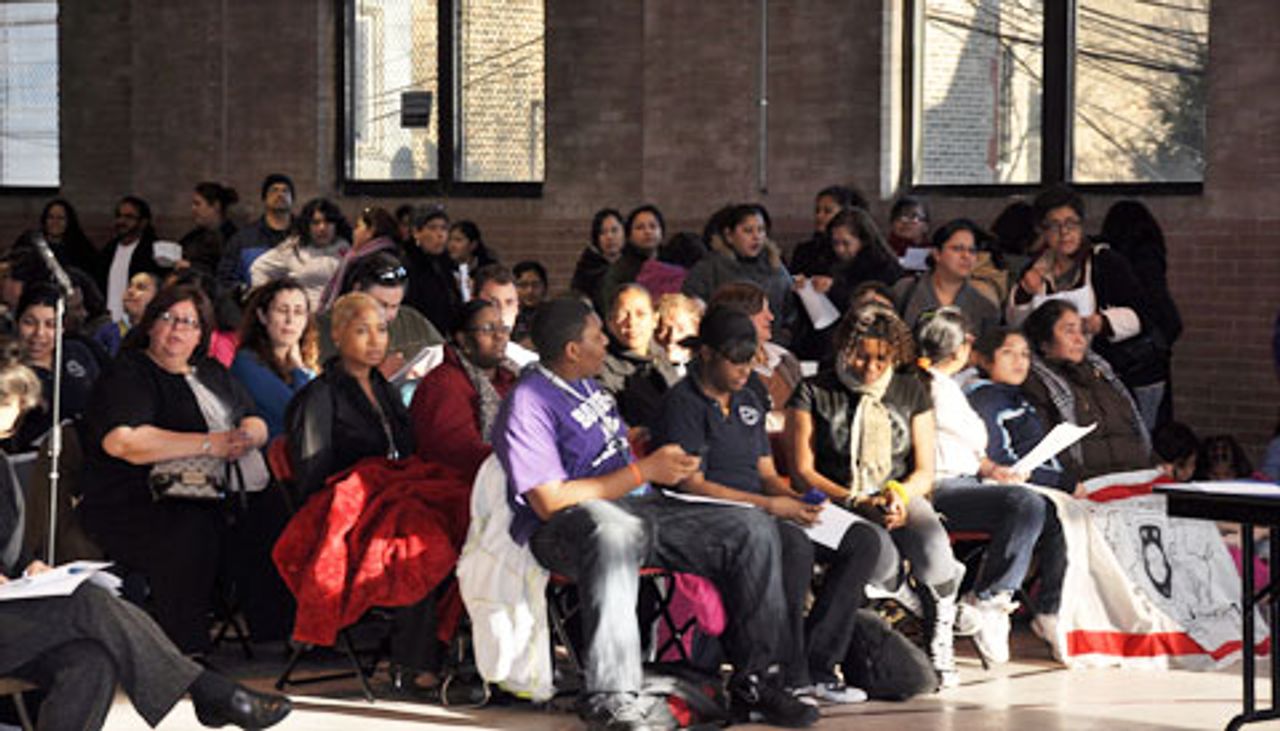Chicago Public Schools (CPS) Interim CEO Terry Mazany has proposed the closure of eight so-called “underused” schools, folding them into six other schools. An estimated 4,800 students will be affected, and at least 200 teaching positions would be eliminated. April 27 is the date set for a vote by the state Board of Education on the consolidations.
 A section of the parents, teachers and students attending the March 28 meeting
A section of the parents, teachers and students attending the March 28 meetingThe proposed closures are part of an effort to bridge Chicago Public Schools’ $720 million budget gap. Over the next two years, between 10 and 30 schools will be closed.
In a Chicago Public Radio interview, Illinois State Representative Cynthia Soto, co-chair of the Chicago Educational Facilities Task Force (CETF), said major problems due to underfunding were identified, including poorly maintained buildings and lack of basic facilities and supplies, like libraries, bathroom stall doors, and hand soap.
In the interview, Soto remarked on CPS’s arbitrary measure for school capacity. Schools that are not enrolled to maximum capacity are determined to be “underused.” CPS does not use the federal measure for capacity, which is 150 gross square feet per student. CPS’s measure is 96 gross square feet per student, making significantly more crowded public schools the norm in Chicago.
The CETF, created by the Illinois Board of Education in 2009 to make non-binding recommendations to the CPS, was not consulted before the closures were announced. The task force was meant to mitigate the autonomy of the CPS board to close and consolidate schools and make capital improvements.
Last summer, CPS fired thousands of teachers before the start of the school year in August. Last week, a federal judge ruled that 750 of those firings were illegal. The injunction against the firings was set into motion last August by the Chicago Teachers Union (CTU). Whether and how that ruling means teachers will be rehired was not specified in the ruling, which is subject to widely varying interpretations.
Democratic State Senator William Delgado has said he filed a federal lawsuit to stop the consolidations. Chicago Tribune reported Delgado as saying, “It’s obvious CPS is continuing its disregard of the legal authority and importance of this [task force].… They continue to move forward like nothing is going on. It’s disrespectful.”
This sentiment is typical of the Democratic Party and the trade union leaders, who accept the “hard facts” of the cuts and simply resent not being part of implementing CPS’s plans. Karen Lewis, president of the CTU, stated that what was “problematic” about the announcement was that the union was not part of the decisions.
CTU representative Rosita Chatonda told the WSWS that the union plans to fight the attacks on the schools by pressuring city leaders to reform the Tax Increment Financing (TIF) programs for better funding for Chicago Public Schools. During the concerted, 20-year-long effort to close, consolidate and privatize public schools in Chicago, the CTU has mounted no principled defense of public education and has proven itself to be content to draw dues from public and charter school teachers.
On March 28, the CETF convened a special session of the Illinois General Assembly to address the closures. It was standing-room-only in the local gymnasium when the session convened. After the Democratic politicians spoke, teachers and parents approached a microphone to state their opposition to the closures, consolidations and layoffs, and what they mean for the students, teachers and parents affected.
The first teacher to speak, Lisa from Carpenter Elementary School, addressed the panel of Democrats very frankly, stating her anger with the way that resources are being distributed. She said, “This is a blatant hijacking of our school by another school on the Gold Coast [a wealthy neighborhood on the near north side]. I’m not worried about my job, I’m worried about my kids. They [CPS] don’t care about our kids and they announce this in the newspaper and that’s how we find out.… Why is it that low-income students are worth less than other students?”
A youth organization leader spoke at length on the dangers of consolidating schools. He said, “The school consolidation will lead to violence. Different social groups and gangs congregate in different schools, different schools with different gangs. Bringing them together is asking for trouble. I want to make that very clear to you. You are putting their lives at risk. Please, please reconsider this.”
At an April 1 protest of parents of the CPS closures, led by the CTU, parents expressed their concern over the safety of their children getting to and from the new schools. In 2009 alone, at least five students, including Derrion Albert, a Fenger High School honors student whose beating death was videotaped by a bystander and broadcast on Fox News, were killed in violence between rival neighborhood youth, inflamed by students moving across the city to different schools.
Outside of the city of Chicago, on March 23, the school board overseeing suburban Community Unit District 300 voted 4-3 to lay off 363 teachers. The following day, 2,000 students at the three high schools in that district walked out in protest against the cuts.
The suburban Courier News reported that District 300 will cut more than $8 million from its budget to cover its budget shortfall. Of that sum, $5.2 million is expected to be given back by the teachers’ unions in the form of wages, benefits and insurance concessions, hoping to prevent the enacting of the layoffs.
Receive news updates and information on the fight against the unsafe reopening of schools.
